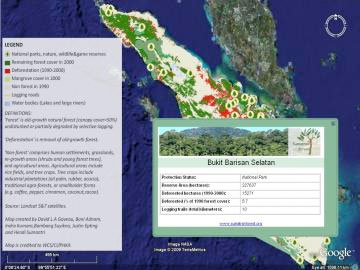|
|
Despite many years of research in conservation biology, precise maps of tropical deforestation that document the global spatial extent of tropical forests destruction are generally not available outside of the scientific community, says David Gaveau a researcher from Durrell Institute of Conservation and Ecology. For nearly seven years, Gaveau has been documenting forest destruction on the island of Sumatra since early 1970s using satellite technology. He publishes his full-resolution maps and scientific results using Google Earth.
 Image courtesy of David Gaveau |
In a move to support the Indonesian government in its mission to inform the general public and decision makers about the true scale of environmental destruction on the island of Sumatra, Gaveau created the first world’s website (sumatranforest.org) that puts precise maps of tropical deforestation freely at user’s fingertips. Through a link on the website, maps of tropical deforestation will unfold onto Google’s digital Earth in full resolution (up to 1:150,000 scale). Internet users will obtain a bird’s-eye view of Sumatran forest landscapes, and the threats they are facing inside and outside protected areas.
“Among the most inspiring and challenging duties we face in the conservation community, is to put the full range of tropical deforestation worldwide for everyone to see to improve ecological transparency, a key requirement of sound environmental governance,” said Gaveau.
Gaveau is now working towards the development of a free online cartographic database of the Earth’s tropical forests, and hopes to find investors that are willing to fund this effort.
“Our duty is to put the full range of tropical deforestation worldwide for everyone to see.”
Sumatra has lost roughly half of its forest cover since 1985, mostly due to logging and conversion for agriculture. Environmental group WWF says there has been an 84 percent decline in elephant populations and a 70 percent in the number of Sumatran tigers on the island since 1982.
sumatranforest.org